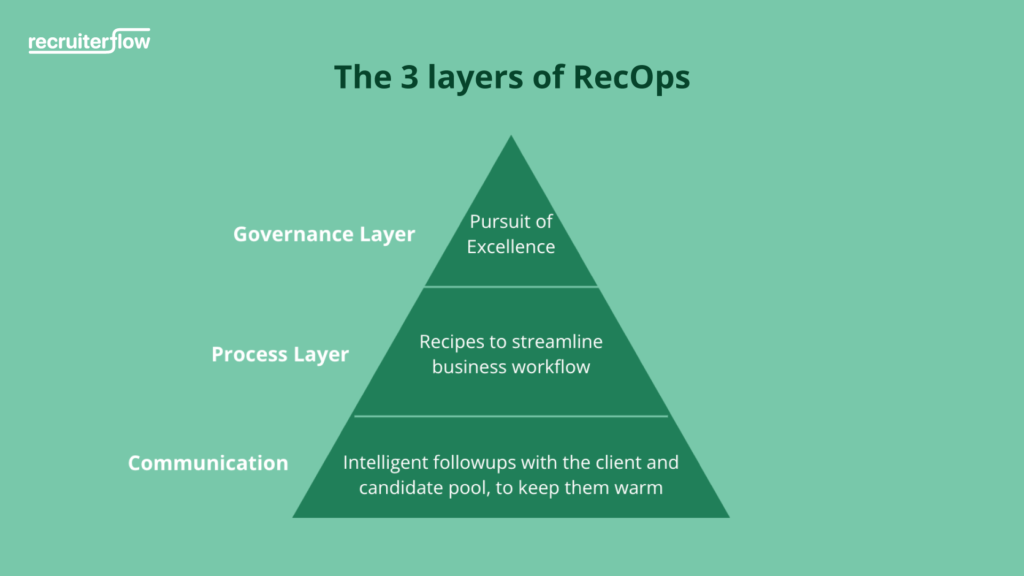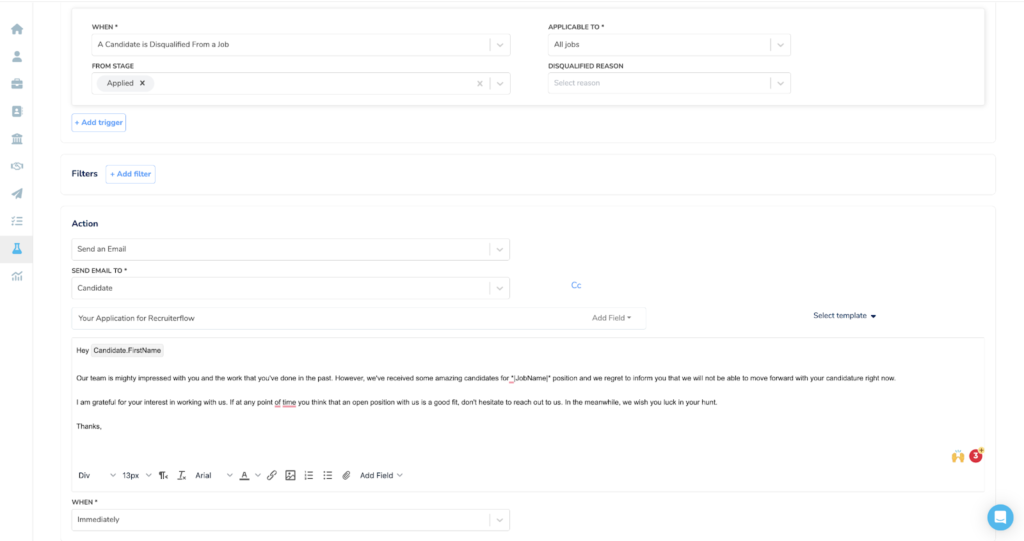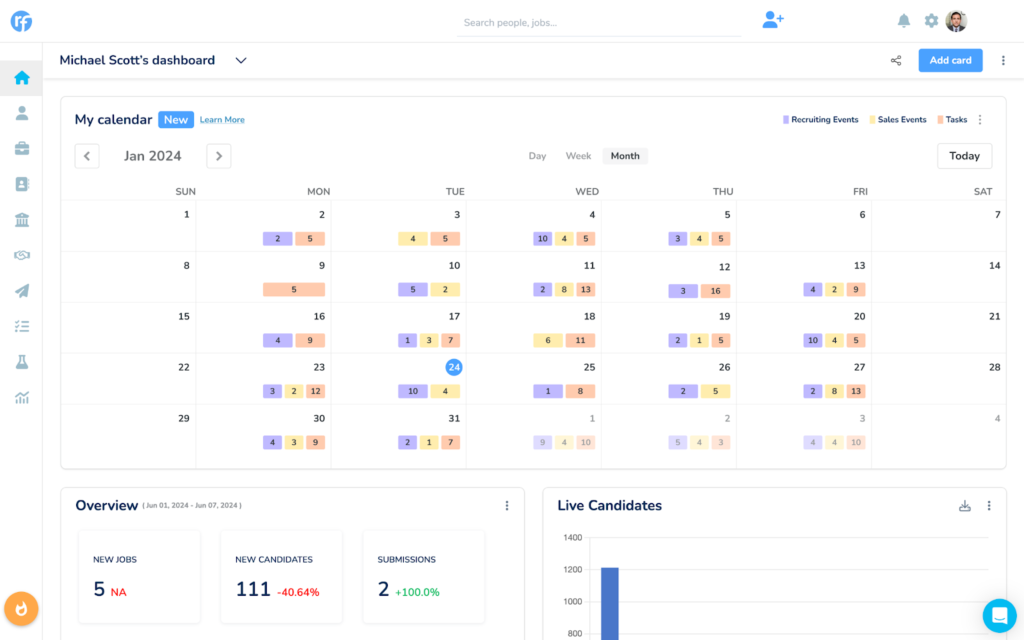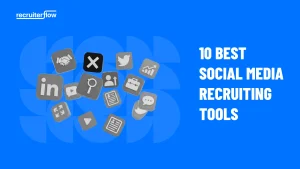
RecOps 101: Mastering Efficient Recruitment Operations

Back in the day, recruitment was largely manual. Relying on paper resumes, job fairs, and personal networks made the process time-consuming and often inefficient.
While the introduction of ATS did make things easier, simply implementing technology wasn’t enough. Agencies needed to make sure these tools were effectively integrated into their broader recruiting strategies.
And as recruitment shifted to remote operations, the complexity increased. Companies had to manage recruitment across multiple geographies, comply with diverse regulations, and cater to different cultural expectations. This shift required a more holistic approach to recruitment, integrating marketing, communication, and operational efficiency.
It wasn’t until late 2020 that 67% of companies started paying attention to optimizing their recruitment operations as part of their post-pandemic strategy.
If you’re thinking about scaling your business and improving your performance metrics, such as client retention rates, time-to-hire, customer acquisition costs, etc, onboarding a RecOps team member is the right way forward.
This guide will walk you through everything you need to know about setting up a RecOps function in your business and hiring your first RecOps team.
What is RecOps (recruitment operations)?
RecOps (Recruitment Operations) is a specialized function in recruiting that focuses on optimizing your end-to-end recruiting process. Much like any operations function within other divisions (such as marketing or sales ops), RecOps handles all the processes and systems that the rest of the team uses.
Think of a RecOps professional as a strategic adviser for your recruiters who make their jobs easier by bringing structure and improvising various operations, such as:
- Workflows
- Compliance processes
- Leveraging the right tech
- Data Analytics
- Improve the overall candidate and recruiter experience
Why the need for RecOps?
You might wonder “Do I need a RecOps function when my recruiters can handle the same?”.
Let us break it to you: The RecOps function already exists in your agency regardless of whether you have a dedicated team or not!
It’s when your most dedicated recruiters strive to make recruiting better by identifying bottlenecks and making incremental process improvements. But take a moment and think—can your recruiters work at full capacity while also focusing on the operational side?
A dedicated RecOps hire will:
- Find bottlenecks in your existing recruiting process and fix them, while your recruiters focus on what they do best—recruiting!
- Create strategies to allocate your recruiting resources better.
- Implement and optimize the recruitment funnel. This involves:
- Collecting historical data on conversion rates at each funnel stage
- Create detailed process maps and Standard Operating Procedures (SOPs) for each stage
- Predict the number of candidates needed at each stage to meet hiring targets
- Work on improving the recruiting efficiency through process improvements and digital transformation.
- De-silo data and make it more accessible to everyone. This can help improve communication and collaboration among recruiters.
- Bring in technologies that enhance candidate, recruiter, and hiring manager experience through recruitment automation.
- Analyze recruiting trends across different regions and skill sets to identify gaps or surpluses in the talent pipeline.
- Bring in the right analytical frameworks to quickly get to the root cause of a problem and use data to inform their decision.

Having a RecOps function will free up your recruiters’ time in 3 ways:
- They can become more strategic in their recruiting approach and still have a helicopter view of what’s happening in their department (thanks to RecOps reporting!).
- They can plan ahead and offer more value to the business rather than getting bogged down in the tactical/delivery of recruitment.
- They can now spend more time upskilling, leading their team, and doing much more.
Who handles RecOps?

A small recruitment agency with 1-2 recruiters and a founder usually doesn’t have a dedicated RecOps function. The founder or a senior recruiter oversees operations in their case.
However, a medium- to large-scale recruiting agency could use a dedicated RecOps team to scale its business further. Typically with 10-20 recruiters and a larger client base, the operations function becomes complex enough to require dedicated resources. At this scale, the volume of candidates, the diversity of client needs, and the intricacies of managing numerous recruiting processes necessitate a more structured approach.
Often, a RecOps Manager or Director leads the effort. That said, the more your agency grows, the bigger your RecOps team size can get—it all depends on the scale of operations, the complexity of client requirements, and the volume of candidates managed.
You can also check out our guide on Recruitment 360 and strategic recruitment plans to enhance your hiring strategy.
How to approach RecOps for your recruiting agency

Since different agencies have different operations needs, it’s ideal to take the following 3-layered approach to building and solidifying the RecOps function in your business.
Communication layer
Ideally, this is where you start streamlining operations in your recruiting process. Ensuring effective communication is a great way to keep the stakeholders aligned and enhance candidates’ experience.
You must look into the three core aspects of streamlining communication:
- Candidate communication
- Structured candidate communication: To standardize communication with candidates, and design templates for offer letters, interview emails, rejection letters, and other correspondence. This will guarantee that all candidate engagements are consistent, professional, and free from unnecessary technical language that might confuse non-technical candidates.
- Candidate relationship management (CRM): Keep track of candidate interactions, check communication histories, and store candidate data using recruitment CRM software.
- Client communication
- Facilitate meetings: Schedule virtual meetings with the hiring managers, and other concerned parties and set up dedicated communication channels to discuss how far you’ve progressed. Additionally, provide them with updates and solve issues that will arise. This helps in transparency and ensures everyone understands each other.
- Maintain transparency: While it’s crucial to assign a single account manager (ideally from the ops function) to be the main point of contact for a client, keeping things transparent using a dedicated client portal can be effective.
Check out how Recruiterflow makes collaborating with clients easy with their easy-to-use client portal:
3. Internal communication
- Internal communication tools: Employ team communication tools like Microsoft Teams or Slack to support team members’ swift and effective internal communication.
- Feedback loops: Ensure that feedback flows freely among your team and recruiters. Also, frequently solicit feedback to identify where improvement opportunities lie.
Process layer
Once you have established a solid communication process, the next step would be to strengthen your process layer. This means developing standardized procedures and automating redundant tasks to improve efficiency and uniformity.
- Standard operating procedures (SOPs): Create detailed SOPs for all important recruiting processes (eg job postings, candidate screening, interviewing, onboarding). These documents should describe each stage of the process, assign responsibilities for each role, give timeline expectations, and define desired results.
- Playbooks: Formulate playbooks that are step-by-step guides for accomplishing certain tasks. Some of these could include instructions on interview conduct, applicant screening, or offer management. Playbooks ensure that the entire team employs best practices and maintains consistency.
- Centralized document management: Save all SOPs, playbooks, templates, and other important documents in a single location that any member of the team can easily access. You can go about this using document management systems such as Google Drive, SharePoint, or Dropbox.
- Process automation: Seek out manual processes that can be done away with to save time and increase efficiency. To accomplish this, use automation tools to create workflows that automate repetitive tasks including sending follow-up emails, updating candidate status in the ATS, and scheduling interviews. Consider implementing a win-back email strategy to re-engage passive candidates and encourage renewed interest in open roles.
In Recruiterflow, we have Recipes to help you automate your repetitive recruiting tasks. As part of your process automation, you can create actions based on specific triggers. For example, you can create a Recipe for sending automated emails to disqualified candidates.

- Process optimization: Continuously examine processes for bottlenecks and areas that need improvement. This will enable you to make informed adjustments based on feedback from team members and data analysis.
Also, read our blog on How to Hire a Recruiter for recruiting and staffing agencies
Governance layer
The governance layer deals with metrics tracking, technology integration, and adherence to legal and industry standards. This layer ensures the oversight and support necessary for a highly effective recruitment setup.
- Tracking metrics: Come up with key performance indicators (KPIs) that can be used to gauge how successful the recruiting process is. Examples of these are time-to-fill, cost-per-hire, offer acceptance rate, candidate satisfaction, and source of hire. Use dashboards and reporting tools in order to visualize and keep track of such metrics frequently.
With Recruiterflow, you get in-built reporting to get actionable insights on your recruiting pipeline and the overall team’s performance.
You get a dashboard that shows a bird’s-eye view of your entire recruitment journey, from the first application to sealing the deal. You can customize and add data fields that are relevant to your business as well.

You can also get actionable reports on your recruiting and sales efforts during a specific period of time. This includes your job pipeline, time-to-fill, milestones achieved, number of deals, contacts, and companies added, number of deals won, your deals pipeline and so much more!

- Tech integration and support: Ensure that all recruiting tools and systems are integrated seamlessly. This includes the ATS, CRM, assessment platforms, scheduling tools, and communication tools. Provide ongoing technical support to troubleshoot issues and optimize the use of technology.
For example, Recruiterflow provides integration with many sourcing, job posting, and screening apps, along with a few AI recruiting tools, which makes it super easy to use these extra functionalities from within the ATS, without having to migrate your data. - Compliance and quality assurance: Implement measures to ensure compliance with legal and regulatory requirements, such as data privacy laws (e.g., GDPR) and equal employment opportunity regulations. Conduct regular audits to ensure adherence to SOPs and identify areas for improvement.
- Risk management: Anticipate likely risks in recruiting processes like data breaches or non-compliance with regulations then devise strategies for reducing these risks. Establish protocols for responding to incidents and conduct regular training to ensure all team members are prepared.
Also, check out our blog on recruiter training to learn how to turn good recruiters into great ones.
Examples of day-to-day responsibilities of a RecOps professional
Let’s say you’re a recruiting agency specializing in IT and finance placements and have a RecOps specialist Alex taking care of operations within the team. Here’s what Alex will typically manage on a day-to-day basis:
Example 1: Guide the recruitment team
So, your recruiters aren’t happy with the current ATS and find it cumbersome to fully utilize its features. They don’t find it easy to use and go through a hard time to even perform simple tasks.
Enters Alex.
Alex will implement a comprehensive training program to help recruiters get acquainted with the ATS. He will:
- Conduct one-on-one interviews with recruiters to understand their pain points and how they are currently using the ATS.
- Analyze usage data to identify underutilized features and common bottlenecks.
- Curate hands-on workshops, video tutorials, and detailed user manuals and knowledge base on ATS.
- Establish a dedicated support channel (e.g., Slack, email) for recruiters to ask questions and receive prompt assistance.
- Set up regular feedback sessions to gather input from recruiters on the training program and workflows.
Meanwhile, Alex will also review and audit the current ATS and see if it serves the purpose or slows down operations. He’ll also look for alternative solutions if necessary.
Example 2: Analyzing data to find bottlenecks
Alex finds out that 30% of candidates drop off during the interview stage. This was mainly due to delays in scheduling and conducting interviews, coordination challenges, and redundant interviews.
So, Alex will address this challenge by bringing in the following changes:
- Reducing manual coordination by implementing an automated interview scheduling tool that’s integrated with the ATS.
- Enabling self-scheduling for candidates, so they can select interview times from a pre-determined set of slots.
- Developing a standardized interview process with clear guidelines and structured interview templates.
- Reducing the number of interview rounds by incorporating assessments where possible.
- Setting up automated reminders and follow-ups through the ATS to ensure timely communication with candidates.
- Creating playbooks on effective communication practices to keep candidates engaged.
Example 3: Enablement and training for recruiters
Now, Alex identifies a critical challenge within the agency: affinity bias. It seems recruiters were unconsciously favoring candidates who are similar to themselves in terms of background, interests, or personality. He found out that 8 out of 10 candidates who were recently recruited went to the same universities as the recruiters who conducted the recruiting.
While this bias is common and often forgivable, it can lead to homogeneity and limit the diversity of the workforce. Here’s how Alex addresses this:
- Creating a comprehensive training program focused on unconscious bias.
- Building SOPs around the interviewing and evaluation processes.
- He develops a structured interview guide with predefined questions focusing on skills and competencies relevant to the role.
- He introduces anonymization techniques within the ATS to hide certain candidate information (e.g., names, ages, gender) during the initial screening stages.
- He integrates bias-reduction tools into the ATS, such as alerts for potentially biased language in job descriptions and candidate evaluations.
- Creates channels for recruiters to provide feedback on the new processes and share their experiences with bias-reduction techniques.
When should you hire your first RecOps team?
Early Stage: If you’re a startup or small company, you may not need a full RecOps team right away. However, hiring a versatile RecOps Manager or Coordinator can help streamline processes early on.
Scaling Stage: As you grow and your hiring needs increase, it becomes crucial to have a dedicated RecOps team to handle the complexity and volume of recruiting activities.
If your company is experiencing rapid growth and high recruiting volumes, a RecOps team can manage the increased workload efficiently.
Ideally, a RecOps division should always be in place no matter what your agency size is. Especially when you want the right infrastructure, workflows, and data practices set since the beginning itself, it’s always a good idea to invest in ops. However, you should look out for these signs that tell you it’s time to make the first dedicated RecOps hire.
- The recruitment manager is starting to lose bandwidth.
- You notice that your candidate and recruiter experience is getting affected by operational inefficiencies.
- You see more demand arising for accurate reporting and forecasting.
- You’re growing to a point where the ops function is no longer a nice-to-have aspect, but a major pillar of your business.
What skills should you look for in a RecOps team member?
When building a Recruiting Operations (RecOps) team, it’s crucial to identify candidates with a blend of technical, analytical, and interpersonal skills. Here are the key skills and qualities to look for in a RecOps team member:
- Technical skills: ATS proficiency, data analytics, and tech stack integration are some must-have skills for a RecOps professional.
- Analytical and problem-solving skills: Dealing with high-volume data and gathering meaningful insights from them should come naturally to them. Plus, they should be able to help the leadership set the right goals by determining the ROI of current tools and systems.
- Context-switching: The ability to juggle multiple things at once and shift focus when necessary. They should be able to handle urgent issues and adjust workflows based on real-time data insights.
- Regulatory knowledge: Familiarity with employment laws and regulations, such as GDPR, EEO, and other relevant laws.
- Organizational skills: Maintaining thorough and organized documentation of all recruitment processes, policies, and activities.
- Change management: Ability to manage change within the recruitment function, including introducing new tools, processes, and policies.
Hiring internally to fill a RecOps role
Do you know who can fit in really well in a RecOps role? Your best recruiter!
That’s right. You can always hire for a RecOps role internally, rather than starting the search for the perfect candidate from scratch. This can be beneficial for you in two ways:
- You save time and fill in the open role quickly
- You can retain your best recruiters by allowing them the chance to level up and pivot from their vertical
So, how do you spot such potential within your team?
Here’s a RecOps specialist’s point of view who has transitioned from recruitment to recruiting operations.
“The transition happened to me as I became the “go-to” person when anyone on the team had questions about our technology or processes. I made it a point to really know the capabilities of our ATS to the fullest extent. I also did this with our dashboards and as we built out more TA analytics. Taking on any opportunities for enablement and training goes a long way when it comes to operations.”
A RecOps specialist from Reddit
As you can see, your potential RecOps hire could be in your team already. All you need is an eye to identify the one by looking for the following qualities and experiences:
- They’re the ones your entire team (including yourself) rely on for tech issues. They’re usually well-versed and up-to-date about the latest recruiting technologies and are adept at identifying and integrating new tools.
- They’re always at ease when it comes to understanding recruiting workflows and identifying areas for improvement.
- They take the initiative in training and enabling team members, ensuring everyone knows how to use recruiting tools effectively.
- They use project management software or have strong such skills, often taking the lead on recruiting initiatives or projects. Plus, they know how to collaborate with other recruiters to achieve recruiting goals.
- They can articulate their ideas clearly and persuasively.
RecOps metrics you should track
Since RecOps is a more data-driven function, it heavily relies on qualitative and quantitative recruiting metrics to identify bottlenecks. You get most of these insights from the recruitment tech you’re using according to your agency’s set goals and KPIs.
Here are some key metrics that are commonly tracked in every RecOps role.
Time-to-fill
Time to fill is the time it takes (in terms of the number of days) between the approval of a job requisition and the day a candidate accepts an offer. The metric depends on a lot of factors: interview coordination within the team and with the candidate, decision-making time at each stage, the time it took to get the hiring manager’s approval, etc.
Shorter times indicate a streamlined process, while longer times may highlight inefficiencies in job postings, candidate screening, or interview coordination. Track trends over time to identify improvements or deteriorations.
For example, suppose your agency’s average time to fill a role is 45 days, but one role took 70 days. In that case, it’s time to evaluate the recruitment stages to identify and address delays.
Offer acceptance rates
This refers to the number of offers that candidates accept within a given period. A high acceptance rate suggests that your job offers are competitive and appealing to candidates. Similarly, a low OAR may indicate issues in your offer that need to be addressed, such as:
- Compensation packages
- Agency’s reputation
- Candidate experience during the recruitment process
Let’s say your agency extended 100 job offers in Q1, but only 60 of those offers were accepted, resulting in an OAR of 60%. Upon analyzing the rejection reasons, you discover that a significant number of candidates declined due to better offers, indicating a possible issue with your compensation packages.
Here’s how you can address this:
- Work with the hiring manager to review and possibly revise your salary and benefits offerings to ensure they are competitive within the industry.
- Improve the interview process to ensure it is smooth, professional, and engaging.
- Consider adding more touchpoints to keep candidates informed and interested throughout the recruiting process.
Candidate experience
A positive candidate experience is crucial to ensure a high offer acceptance rate. It impacts how candidates perceive your agency, even if they don’t get the job, which can influence future applications and referrals.
It’s essential to send candidate experience surveys to both hired and rejected candidates. Like other key metrics, track this survey data over time to identify trends and areas for improvement.
Let us show you an example to help you understand why this metric is important.
Let’s say after a recruitment drive, you received an NPS rating of +10, with common qualitative feedback indicating that candidates felt there were too few touchpoints during the process.
Here’s how you can address this:
- Ensure candidates receive regular updates about their application status, including next steps and timelines.
- Reduce the time between application stages to keep candidates engaged and reduce uncertainty.
Recruiter experience
A positive recruiter experience ensures that recruiters are motivated, productive, and equipped to attract and retain top talent. Often their experience has to do with how convenient it is for them to work with the existing tools and processes. For example, it might be a clunky ATS that puts them off or a tardy manual process they hate to go over again and again.
Here’s how you should measure and improve it:
- Conduct regular surveys to gauge recruiter satisfaction and gather feedback on tools, processes, and overall work environment.
- Invest in ongoing training and development programs to help recruiters improve their skills and stay updated with the latest recruitment trends and technologies.
- Track performance metrics such as time-to-fill, quality of hire, and candidate experience scores to check if they need any additional support to meet their KPIs.
The essential RecOps tech stack
A large chunk of a RecOps professional’s responsibilities includes handling tech and streamlining processes. Thankfully, a lot of options are available in the market today that make recruiting a more fun process for recruiters. And, a RecOps professional’s job is to introduce these solutions to the team and make sure they’re used in the right way.
Based on the many responsibilities a RecOps professional handles on a day-to-day basis, they’ll need multiple tools to navigate in their role. This includes:
- Recruiting tools
- An applicant tracking system
- An interview scheduling tool
- A video interviewing platform
- A talent assessment tool
- A resume-parsing tool
- A reporting tool
- A candidate sourcing tool
- A candidate screening tool
- Client collaboration tools
- A client communication tool
- A client CRM
- A platform to pitch candidates
Sounds like a lot, right? It’s not even the entire list of tools you might need—just a few of them! The best part is—you don’t even need to go through the hassle of onboarding your data in each of these tools. You just need one recruiting tool and integrate all the other tools into that platform, so your RecOps team can manage their tasks and data from a centralized system.
An applicant tracking system (ATS) and CRM system like Recruiterflow allow you to track your candidates effectively and stay in touch with them throughout the recruiting process. You can even manage your leads and clients’ data on the same platform and integrate a lot of other tools to keep things simple.
For example, by integrating a job posting platform, you can make use of both the ATS and the many functionalities of the job posting platform such as AI matching, talent pool management, AI sourcing, and more!
Another recruiting tool that comes in very handy to manage your customer data in a CRM. However, with the addition of a client portal in Recruiterflow, you get the complete package without worrying about data migration, data extraction, or learning a new tool.
Elevate your recruiting metrics with RecOps
Recruitment operations as a function sure are evolving at lightning speed, and so are AI and automation! This advancing technology is empowering RecOps professionals to focus on what truly matters—building relationships and driving strategic growth.
If done right, streamlining your recruitment operations has the potential of 3xing your productivity, reducing customer churn, and even lowering candidate drop-off rate. And the best way forward is to pinpoint the time-consuming tasks and build a faster process around them by bringing automation to the grind.
The key to strengthening your operations function is to keep an eye on your top recruiters and see if there’s potential to pivot into the operations role. Make sure your ops team is more tightly integrated with other business functions and has all the necessary data visualization, analytics, and AI recruiting tools to inform their decision-making.
To take your recruitment operations to the next level, it’s crucial to have clear strategies in place. For expert advice and actionable steps, you can watch our exclusive webinar on Strategies for Implementing Recruitment Operations. Learn from industry leaders as they discuss proven methods to optimize and scale your recruitment processes.
Now go, step up your recruiting game with RecOps!
Book a free demo.


